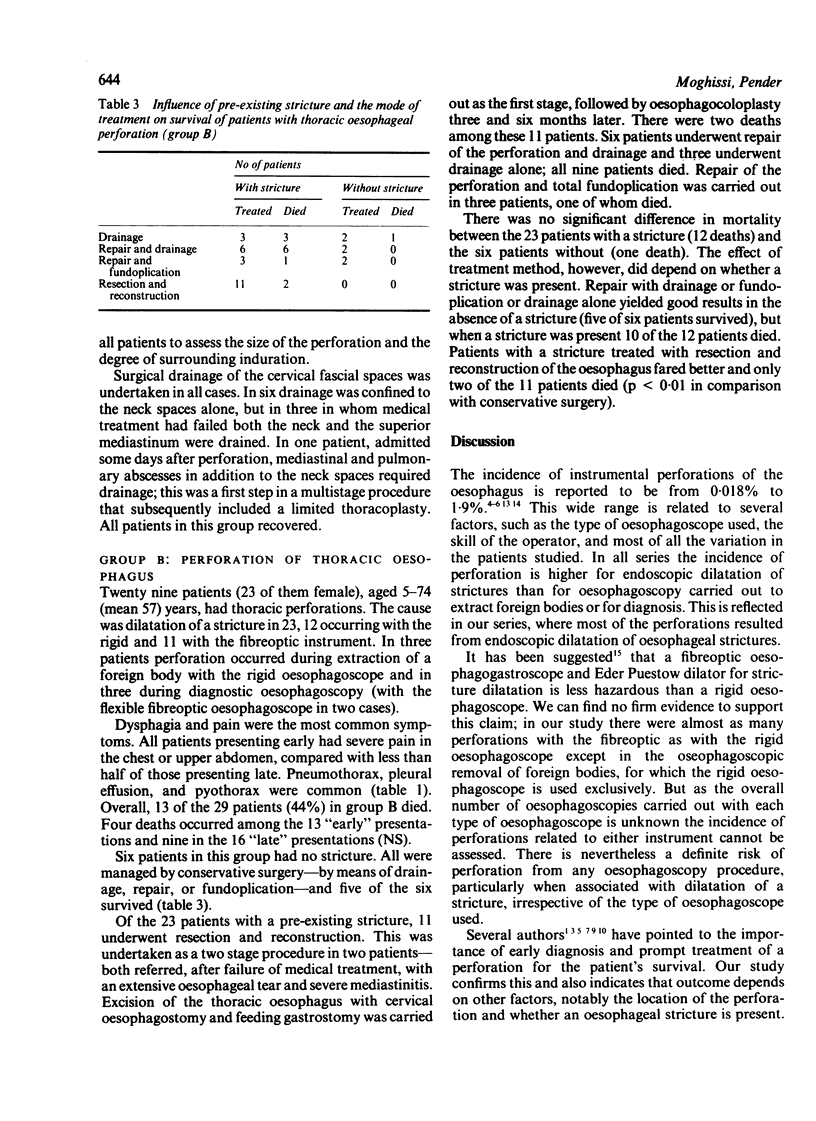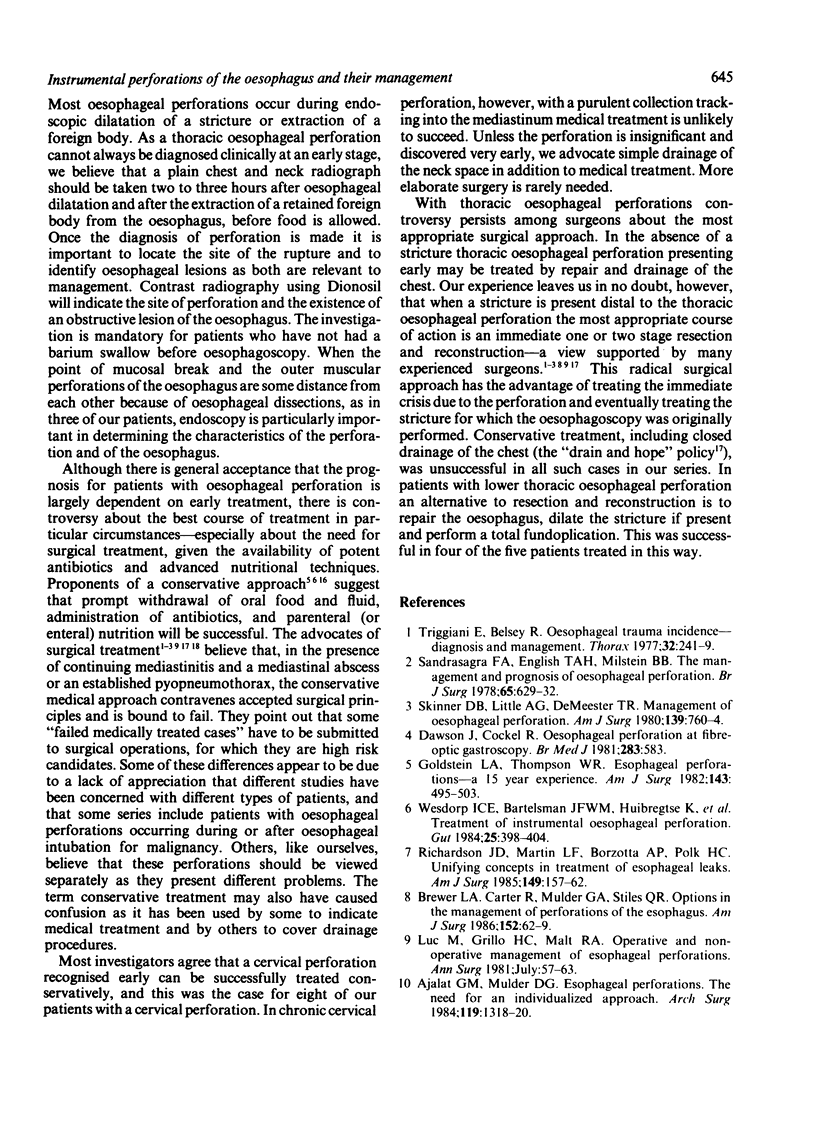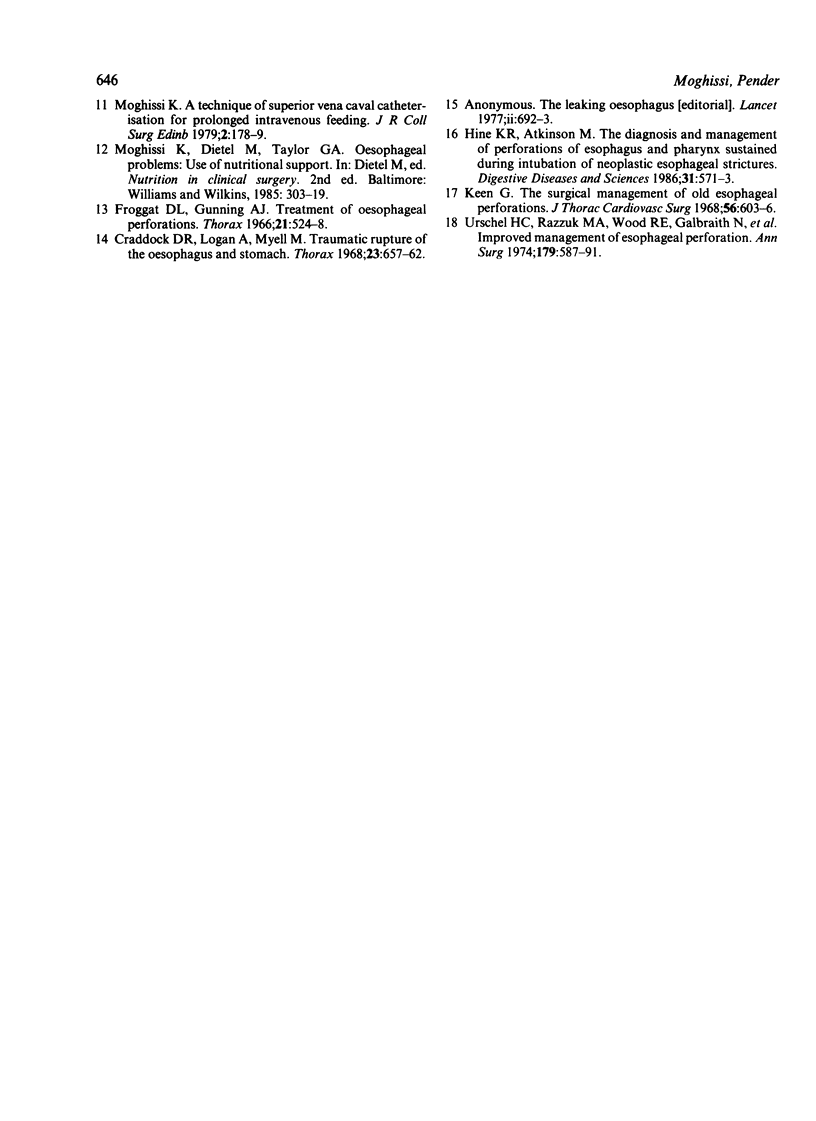Abstract
The records of 39 patients who had developed a perforation of the oesophagus after instrumentation were reviewed. Ten (group A) had cervical and 29 (group B) thoracic oesophageal perforation. Twenty three perforations occurred during dilatation of an oesophageal stricture, 10 during oesophagoscopic removal of a foreign body, and six during diagnostic oesophagoscopy. Of the 21 patients treated within 36 hours (early treatment group), four (19%) died; of the 18 treated more than 36 hours after the perforation (late treatment group), nine (50%) died. None of the 10 patients in group A had strictures and only two presented late. After drainage of the neck and mediastinum the outcome was successful in all patients. Thirteen of the 29 in group B were treated early and four of these died; nine of the 16 treated late died, the total mortality for thoracic perforation being 48%. An oesophageal stricture was present in 23 patients. Twelve of these underwent various forms of conservative surgery and there were 10 deaths. This contrasts with the 11 who received radical treatment with resection and reconstruction, only two of whom died. The six patients with no pre-existing stricture were treated with conservative forms of surgery, with one death.
Full text
PDF




Selected References
These references are in PubMed. This may not be the complete list of references from this article.
- Ajalat G. M., Mulder D. G. Esophageal perforations. The need for an individualized approach. Arch Surg. 1984 Nov;119(11):1318–1320. doi: 10.1001/archsurg.1984.01390230084021. [DOI] [PubMed] [Google Scholar]
- Brewer L. A., 3rd, Carter R., Mulder G. A., Stiles Q. R. Options in the management of perforations of the esophagus. Am J Surg. 1986 Jul;152(1):62–69. doi: 10.1016/0002-9610(86)90144-3. [DOI] [PubMed] [Google Scholar]
- Craddock D. R., Logan A., Mayell M. Traumatic rupture of the oesophagus and stomach. Thorax. 1968 Nov;23(6):657–662. doi: 10.1136/thx.23.6.657. [DOI] [PMC free article] [PubMed] [Google Scholar]
- Dawson J., Cockel R. Oesophageal perforation at fibreoptic gastroscopy. Br Med J (Clin Res Ed) 1981 Aug 29;283(6291):583–583. doi: 10.1136/bmj.283.6291.583. [DOI] [PMC free article] [PubMed] [Google Scholar]
- Froggatt D. L., Gunning A. J. Treatment of oesophageal perforation. Thorax. 1966 Nov;21(6):524–528. doi: 10.1136/thx.21.6.524. [DOI] [PMC free article] [PubMed] [Google Scholar]
- Goldstein L. A., Thompson W. R. Esophageal perforations: a 15 year experience. Am J Surg. 1982 Apr;143(4):495–503. doi: 10.1016/0002-9610(82)90202-1. [DOI] [PubMed] [Google Scholar]
- Hine K. R., Atkinson M. The diagnosis and management of perforations of esophagus and pharynx sustained during intubation of neoplastic esophageal strictures. Dig Dis Sci. 1986 Jun;31(6):571–573. doi: 10.1007/BF01318687. [DOI] [PubMed] [Google Scholar]
- Keen G. The surgical management of old esophageal perforations. J Thorac Cardiovasc Surg. 1968 Oct;56(4):603–606. [PubMed] [Google Scholar]
- Michel L., Grillo H. C., Malt R. A. Operative and nonoperative management of esophageal perforations. Ann Surg. 1981 Jul;194(1):57–63. doi: 10.1097/00000658-198107000-00010. [DOI] [PMC free article] [PubMed] [Google Scholar]
- Moghissi K. A technique of superior vena caval catheterisation for prolonged intravenous feeding. J R Coll Surg Edinb. 1979 May;24(3):178–179. [PubMed] [Google Scholar]
- Richardson J. D., Martin L. F., Borzotta A. P., Polk H. C., Jr Unifying concepts in treatment of esophageal leaks. Am J Surg. 1985 Jan;149(1):157–162. doi: 10.1016/s0002-9610(85)80026-x. [DOI] [PubMed] [Google Scholar]
- Sandrasagra F. A., English T. A., Milstein B. B. The management and prognosis of oesophageal perforation. Br J Surg. 1978 Sep;65(9):629–632. doi: 10.1002/bjs.1800650912. [DOI] [PubMed] [Google Scholar]
- Skinner D. B., Little A. G., DeMeester T. R. Management of esophageal perforation. Am J Surg. 1980 Jun;139(6):760–764. doi: 10.1016/0002-9610(80)90379-7. [DOI] [PubMed] [Google Scholar]
- Triggiani E., Belsey R. Oesophageal trauma: incidence, diagnosis, and management. Thorax. 1977 Jun;32(3):241–249. doi: 10.1136/thx.32.3.241. [DOI] [PMC free article] [PubMed] [Google Scholar]
- Urschel H. C., Jr, Razzuk M. A., Wood R. E., Galbraith N., Pockey M., Paulson D. L. Improved management of esophageal perforation: exclusion and diversion in continuity. Ann Surg. 1974 May;179(5):587–591. doi: 10.1097/00000658-197405000-00010. [DOI] [PMC free article] [PubMed] [Google Scholar]
- Wesdorp I. C., Bartelsman J. F., Huibregtse K., den Hartog Jager F. C., Tytgat G. N. Treatment of instrumental oesophageal perforation. Gut. 1984 Apr;25(4):398–404. doi: 10.1136/gut.25.4.398. [DOI] [PMC free article] [PubMed] [Google Scholar]


